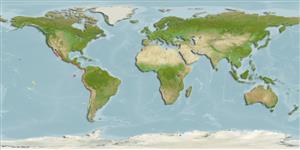Actinopterygii (ray-finned fishes) >
Pleuronectiformes (Flatfishes) >
Paralichthyidae (Large-tooth flounders)
Etymology: Hippoglossina: Greek, ippos = horse + Greek, glossa = tongue (Ref. 45335). More on author: Gilbert.
Environment / Climate / Range
Ecology
Marine; demersal; depth range 66 - 121 m (Ref. 9330). Tropical, preferred ?; 27°N -
Eastern Pacific: Gulf of California to Peru.
Size / Weight / Age
Maturity: Lm ? range ? - ? cm
Max length : 20.0 cm TL male/unsexed; (Ref. 55763); common length : 18.0 cm TL male/unsexed; (Ref. 55763)
Inhabits soft or rocky bottoms. Exploited on a local level with trawl nets and is utilized fresh or as fishmeal.
Life cycle and mating behavior
Maturity | Reproduction | Spawning | Eggs | Fecundity | Larvae
Distinct pairing (Ref. 205).
Hensley, D.A., 1995. Paralichthyidae. Lenguados. p. 1349-1380. In W. Fischer, F. Krupp, W. Schneider, C. Sommer, K.E. Carpenter and V. Niem (eds.) Guia FAO para Identification de Especies para lo Fines de la Pesca. Pacifico Centro-Oriental. 3 Vols. FAO, Rome. (Ref. 9330)
IUCN Red List Status (Ref. 115185)
CITES (Ref. 94142)
Not Evaluated
Threat to humans
Harmless
Human uses
Fisheries: minor commercial
More information
ReferencesAquacultureAquaculture profileStrainsGeneticsAllele frequenciesHeritabilityDiseasesProcessingMass conversion
Tools
Special reports
Download XML
Internet sources
